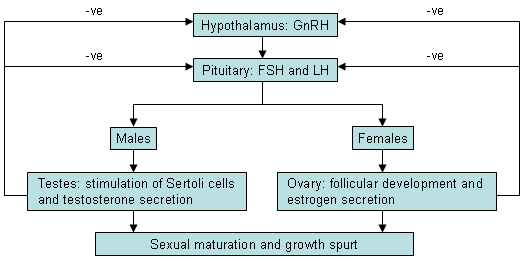Etiology
The majority of patients presenting with delayed puberty have a temporary delay due to a central inhibition of the hypothalamo-pituitary axis that resolves with time and serial observation or a short course of sex steroids (functional delay).
Constitutional (also called self-limited) delay is the most common cause of delayed puberty in both males and females.[1][19] It tends to occur within families (50% to 75% of cases) and is associated with short stature that is appropriate for the bone age.[1][19][20] It may be difficult to distinguish from organic gonadotropin deficiency.
A temporary or reversible delay in puberty may also occur due to any chronic illness in children (e.g., cystic fibrosis, inflammatory bowel disease, celiac disease, poorly controlled diabetes mellitus), excessive physical exercise, malnutrition, and eating disorders (anorexia nervosa).
Organic causes may be due to a hypothalamo-pituitary cause or due to gonadal abnormality.
Hypothalamo-pituitary disorders
Hypogonadotropic hypogonadism may be congenital or acquired, and can be isolated or be associated with combined pituitary hormone deficiencies. If associated with the phenotype of anosmia, it is named Kallmann syndrome.[21] It may also be associated with midline brain disorders in septo-optic dysplasia and holoprosencephaly, adrenal hypoplasia, or with other syndromes such as Prader-Willi, Bardet-Biedl, and CHARGE syndromes.[22][23] Partial forms of hypogonadotropic hypogonadism are also seen, sometimes with normally timed entry into puberty followed by pubertal arrest, and these can be particularly difficult to distinguish from constitutional (self-limited) delayed puberty.
More than 50 genes have been linked to the pathogenesis of congenital hypogonadotropic hypogonadism, including ANOS1, FGFR1, KISS1R, KISS-1, GNRHR, PROK2, PROKR2, NSMF, NROB1, LH and FSH beta-subunit, leptin, leptin receptor, and prohormone convertase 1 (PC1) genes.[24]
Acquired forms of hypogonadotropic hypogonadism are associated with intracranial trauma, tumors, surgery, or radiation therapy.[25] Histiocytosis, sickle cell disease, and iron overload (associated with transfusion) can result in permanent gonadotropin deficiency.[26]
Gonadal disorders
Clinical signs of congenital disorders include cryptorchidism/anorchia.
Chromosomal disorders include Klinefelter syndrome (XXY), Turner syndrome (45X), XY gonadal dysgenesis, and 45X/46XY mixed gonadal dysgenesis.[27][28] Primary ovarian insufficiency has been associated with deficiency in several underlying genes including FMR1, FMR2, BMP15, DIAPH2, and FOXL2.
Acquired causes include testicular torsion, polyglandular autoimmune diseases, chemotherapy, viral infections (e.g., mumps), pelvic or abdominal radiation, and testicular or ovarian surgery.[29][30]
Pathophysiology
The onset of puberty is controlled by several factors.[6] A nocturnal increase in the amplitude and pulsatility of gonadotropin-releasing hormone (GnRH) secretion from the hypothalamus is the first evidence of the pubertal activation of the hypothalamic-pituitary-gonadal axis.[31] Other neurotransmitters (e.g., acetylcholine, gamma-aminobutyric acid, opioid peptides, prostaglandins, and serotonin) and leptin may modulate the onset of puberty. KISS1R is a G-protein-coupled receptor that is a ligand for kisspeptin, and stimulation of the kisspeptin-1 receptor (located on GnRH neurons) by kisspeptin is necessary for GnRH secretion.
Hypothalamic GnRH in turn stimulates the secretion of pituitary hormones: follicle-stimulating hormone (FSH) and luteinizing hormone (LH). FSH stimulates Sertoli cells in the male, producing spermatogonia, and follicular cells in the female, resulting in ovulation. LH regulates testosterone and estrogen production.
Abnormal pubertal development may be due to:
Hypogonadotropic hypogonadism, resulting from a lack of serum gonadotropin production or action, and manifesting with an absence of spontaneous pubertal development. This occurs in patients with hypothalamo-pituitary disorders and in those with a functional delay (constitutional delay, underlying chronic disease, malnutrition, or excessive exercise). Permanent hypogonadotropic hypogonadism accounts for approximately 10% of delayed puberty cases in boys and 20% in girls, whereas functional hypogonadotropic hypogonadism accounts for 15% to 20% of cases in boys and 20% to 30% in girls.[17][18][32]
Hypergonadotropic hypogonadism, resulting from gonadal disorders, and manifesting with elevated serum gonadotropin concentrations in the absence of pubertal signs at the appropriate age for puberty. It accounts for approximately 5% to 10% of delayed puberty cases in boys and 25% in girls.[17][18][32][Figure caption and citation for the preceding image starts]: Hypothalamo-pituitary-gonadal feedback loop. GnRH, gonadotropin-releasing hormone; FSH, follicle-stimulating hormone; LH, luteinizing hormoneFrom the collection of Dr A. Mehta [Citation ends].

On average, puberty takes approximately 2 to 5 years to complete and provides a growth potential of 25 cm (10 inches) in girls and 30 cm (12 inches) in boys. The sex hormones directly stimulate the growth plate, resulting in an increased height velocity. There is also an increase in GH secretion.[33] Estrogen, either from the ovary or aromatized from testicular testosterone, is the factor that mediates the increased GH response during puberty.[34]
Classification
Etiologic classification
Hypogonadotropic hypogonadism
Results from a lack of serum gonadotropin production or action, which manifests as an absence of spontaneous pubertal development. This is usually due to a hypothalamo-pituitary abnormality. Partial forms also occur that can result in delayed or arrested puberty.
Constitutional delay and other functional causes of delay such as chronic illness, malnutrition, and excessive exercise also result in low gonadotropin concentrations. They cause a temporary delay or a slow progress of puberty.
Hypergonadotropic hypogonadism
Elevated serum gonadotropin concentrations in the absence of pubertal signs at the appropriate age for puberty suggest gonadal insufficiency.
Examples include Turner syndrome and Klinefelter syndrome.
Use of this content is subject to our disclaimer